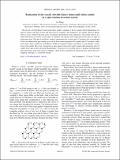| dc.contributor.author | Wang, Fa | |
| dc.date.accessioned | 2010-09-30T14:24:30Z | |
| dc.date.available | 2010-09-30T14:24:30Z | |
| dc.date.issued | 2010-05 | |
| dc.date.submitted | 2010-04 | |
| dc.identifier.issn | 1098-0121 | |
| dc.identifier.issn | 1550-235X | |
| dc.identifier.uri | http://hdl.handle.net/1721.1/58777 | |
| dc.description.abstract | The exactly solvable Kitaev honeycomb lattice model is realized as the low-energy effect Hamiltonian of a spin-1/2 model with spin rotation and time-reversal symmetry. The mapping to low-energy effective Hamiltonian is exact without truncation errors in traditional perturbation series expansions. This model consists of a honeycomb lattice of clusters of four spin-1/2 moments and contains short-range interactions up to six-spin (or eight-spin) terms. The spin in the Kitaev model is represented not as these spin-1/2 moments but as pseudospin of the two-dimensional spin-singlet sector of the four antiferromagnetically coupled spin-1/2 moments within each cluster. Spin correlations in the Kitaev model are mapped to dimer correlations or spin-chirality correlations in this model. This exact construction is quite general and can be used to make other interesting spin-1/2 models from spin-rotation invariant Hamiltonians. We discuss two possible routes to generate the high-order spin interactions from more natural couplings, which involves perturbative expansions thus breaks the exact mapping, although in a controlled manner. | en_US |
| dc.language.iso | en_US | |
| dc.publisher | American Physical Society | en_US |
| dc.relation.isversionof | http://dx.doi.org/10.1103/PhysRevB.81.184416 | en_US |
| dc.rights | Article is made available in accordance with the publisher's policy and may be subject to US copyright law. Please refer to the publisher's site for terms of use. | en_US |
| dc.source | APS | en_US |
| dc.title | Realization of the exactly solvable Kitaev honeycomb lattice model in a spin-rotation-invariant system | en_US |
| dc.type | Article | en_US |
| dc.identifier.citation | Wang, Fa. “Realization of the exactly solvable Kitaev honeycomb lattice model in a spin-rotation-invariant system.” Physical Review B 81.18 (2010): 184416. © 2010 The American Physical Society | en_US |
| dc.contributor.department | Massachusetts Institute of Technology. Department of Physics | en_US |
| dc.contributor.approver | Wang, Fa | |
| dc.contributor.mitauthor | Wang, Fa | |
| dc.relation.journal | Physical Review B | en_US |
| dc.eprint.version | Final published version | en_US |
| dc.type.uri | http://purl.org/eprint/type/JournalArticle | en_US |
| eprint.status | http://purl.org/eprint/status/PeerReviewed | en_US |
| dspace.orderedauthors | Wang, Fa | en |
| mit.license | PUBLISHER_POLICY | en_US |
| mit.metadata.status | Complete | |
